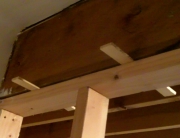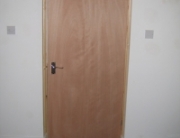How to Guide: Soldering Copper Pipe. There may come a time when you need to fix your copper plumbing pipes or apply a new valve or fixture, among other possibilities. We believe that soldering copper pipe is absolutely doable by the homeowner who has some received some basic training. This is what we provide in the following written instructions (there is also a free downloadable version below with pictures!) and the attached how-to video: “How to Sweat (Solder) and Attach Copper Pipe.”
Follow our step-by-step guide, and you can most certainly do this!
Tools and Materials Needed to Complete the Job
- Eye Protection (Safety Glasses)
- Copper pipe and/or copper pipe fittings (Note: If you need assistance with cutting any of the copper pipe prior to soldering it, review the video “How to Cut Copper Pipe with a Tubing Cutter”)
- A Copper Pipe Cleaning Tool and/or Emery Cloth or Steel Wool
- Lead-free Solder
- Flux paste, preferably the water-soluble type
- Flux brush
- Wet rag (optional)
- MAPP Gas Torch
or Propane Torch (Note: See Jane Drill recommends the use of a MAPP torch if feasible. The job can be completed with the use of a propane torch, however, expect it to take longer for the copper to heat up. If you need assistance with how to set up and use a MAPP Gas Torch, review the video “How to Set up and Operate a MAPP Gas Torch”)
Special Safety Requirements
- The MAPP gas torch (or propane), if not already set up, needs to be prepared outside the house.
- The soldering working area should be free of any flammable material. Depending upon the area in which you will be working, you may need to use a flame-retardant barrier. There are several types available from home-improvement stores. Also, try to wet down any surrounding wood after completing the soldering process. This will help to ensure that there are no smoldering embers present.
- Special note about stop valve interiors: The heat required to melt solder can damage the rubber washer of a valve. It is best to remove the handle and stem of the valve, prior to soldering.
Steps to Sweat (Solder) and Attach Copper Pipe
Preparation
- Shut off the water and ensure that the pipe you will be soldering is absolutely dry. This is critical to ensure that the solder will adhere. To dry the copper pipe, do the following after shutting off the water: Drain the line you will be working on by opening the faucet. Also open a faucet as low in the house as possible to release steam. Tip: Right before beginning to solder, stuff bread up into the pipe you will be working on to absorb any remaining moisture. The bread will dissolve later on when you run the water.
- Measure, Cut and de-bur the copper pipe you will be soldering.
- Clean the pipe and fittings: If you have an emery cloth or steel wool, wrap it around the end of the pipe and twist, until the pipe is shiny and clean, like a new penny. You can get inside the pipe with the emery cloth or steel wool if you have to, but it is preferable to use a pipe cleaning tool. If you have a pipe cleaning tool, you can use it to clean both the inside and outside of the pipes and fittings, where they will be joined together. Simply insert the end of the pipe into the pipe cleaner and twist, to clean the outside of the pipe. To clean the inside, use the brush that is at the end of the pipe cleaner. Clean the inside and outsides of all pipes and fittings that will be joined together. Don’t forget about the existing pipe that you will be attaching the new pipe to, as it also needs to be cleaned and de-burred.
- The dry fit: Before beginning the soldering process, dry fit your copper pipes and fittings to make sure that you have made the proper measurements for the piece(s) that you are replacing.
- Apply flux: Apply flux paste with a flux brush around the inside and outside of the pipes and fittings, where they will be joined together. The flux paste should cover about 1 inch on each piece.
- Assemble the pieces. Assemble the pipes and fittings that you will be soldering together.
Soldering
- First, put on your eye protection.
- Prepare the spool of solder by extending a length of it out 8 or more inches from the spool in a curved shape, as shown below. The idea is to create distance between your hand and the area where you will be soldering the hot metal.
- Set the solder aside, and start the torch. The flame should be blue.
- Begin heating up the connection by putting the flame of the torch right on the center of the fitting.
- After 5 – 10 seconds, test whether or not the fitting is hot enough to melt the solder, by placing the tip of the solder along the edge of the fitting. If the copper is hot enough, the solder will melt immediately and start to spread. If not, wait 2 -3 more seconds and try again.
- Once the copper is hot enough, you’ll want to remove the flame and then carefully and quickly move the tip of the solder around the ridges where the fitting meets the pipe (on both sides). Capillary action will enable the solder to sink into the opening, creating a tight seal as it cools and dries. If necessary, apply more heat.
- For a professional appearance, clean off any drips and excess solder with a wet rag, being careful to not touch the metal with your hand, as it is still very hot. (optional step)
- Now, test the joint by running the water. (On the off chance that you should spot a leak when testing the new joint, don’t despair. This sometimes happens, even to professionals. You will need to dry out the pipe again, re-heat the joint, and apply more solder. This should correct the problem, however, if it doesn’t, you will need to twist off the fitting and start the soldering process over with a brand-new fitting. )
And that’s it! You did it! You have just sweated/soldered copper pipe.
For further information about the task described in this worksheet and the tools and materials needed to complete this job, refer to www.seejanedrill.com
Due to differing conditions, tools, and individual skills, See Jane Drill assumes no responsibility for any mistakes, damages, injuries suffered, or losses incurred as a result of following the information published on our website and in the videos and written instructions published through our website. Before beginning any project, review the instructions carefully, and if you still have any doubts or questions about how to complete the project, consult with local experts or authorities. Also, because codes and regulations vary greatly by location, you should check to ensure that your project complies with all applicable local codes and regulations. Always read and follow all the safety precautions provided by any tool or equipment manufacturer, and follow all accepted safety procedures.
See Jane Drill is dedicated to providing accurate and helpful do-it-yourself information. We welcome your questions, input and feedback about the information provided on this website.
By See Jane Drill, Copyright 2013, All Rights Reserved





Leave A Comment